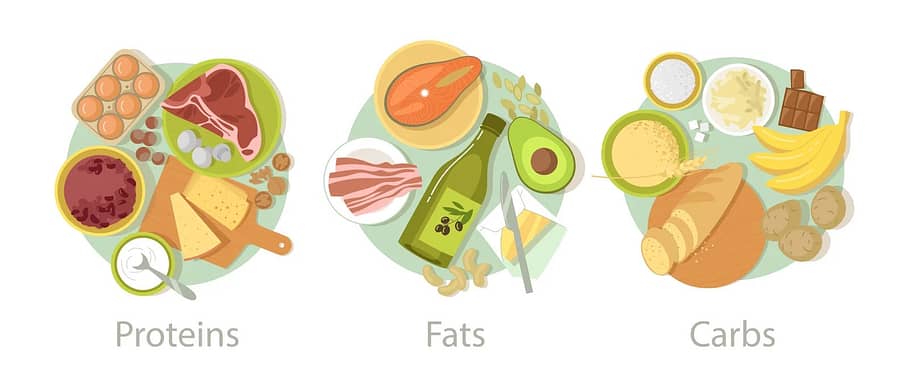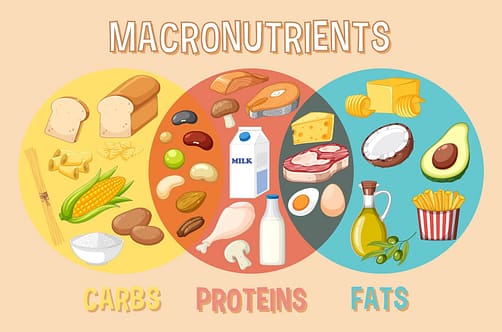The secret to successful weight loss lies not just in what you eat, but also in understanding the three essential macronutrients: carbohydrates, proteins, and fats. Balancing these macronutrients optimally is crucial for achieving sustainable weight loss on a vegetarian diet. In this article, we’ll delve into the world of macronutrients, what are macronutrients , breaking down their roles and offering insights on how to strike the right balance to achieve your weight loss goals.
What Are Macronutrients?
Before delving into the specifics of how macronutrients contribute to effective weight loss on a vegetarian diet, let’s first understand what they are. Macronutrients are the three primary types of nutrients that provide the energy our bodies need to function optimally: carbohydrates, proteins, and fats.

Macronutrients: The Building Blocks of Nutrition
1. Carbohydrates:
Carbohydrates are the body’s primary source of energy. They come in two main forms: simple and complex. Simple carbohydrates, found in sugars and refined foods, provide quick bursts of energy but can lead to blood sugar spikes and crashes. Complex carbohydrates, found in whole grains, legumes, and vegetables, release energy more slowly and sustainably. When aiming for weight loss, focus on consuming complex carbohydrates, as they provide a steady source of energy, reduce cravings, and aid in maintaining stable blood sugar levels.
2. Proteins:
Proteins are essential for repairing and building tissues, supporting immune function, and maintaining muscle mass. Plant-based sources of protein include legumes (beans, lentils, chickpeas), tofu, tempeh, quinoa, nuts, and seeds. When aiming for weight loss, consuming an adequate amount of protein is crucial. Protein-rich foods help you feel full and satisfied, reducing the likelihood of overeating and promoting muscle preservation during weight loss.
3. Fats:
Dietary fats play a role in hormone production, cell structure, and nutrient absorption. Healthy fats, such as those found in avocados, nuts, seeds, and olive oil, are an essential part of a balanced diet. While fats are calorie-dense, they contribute to satiety and can help regulate appetite. Incorporating moderate amounts of healthy fats into your meals can aid in weight loss by preventing excessive hunger and promoting a feeling of fullness.
Balancing Macronutrients for Weight Loss

1. Understanding Portion Sizes:
Portion control is fundamental when it comes to effective weight loss. While carbohydrates are essential, focusing on portion sizes can prevent overconsumption. Opt for whole grains like brown rice, quinoa, and whole wheat pasta. Fill your plate with non-starchy vegetables, as they’re low in calories and high in nutrients. A quarter of your plate can be dedicated to a lean protein source, such as tofu, legumes, or tempeh. Finally, include a small portion of healthy fats, like avocado or nuts, to round out your meal.
2. Meal Planning:
Planning your meals ahead of time can help you maintain a balanced intake of macronutrients. Incorporate a variety of plant-based protein sources throughout the week to ensure you’re meeting your protein needs. Include a mix of colorful vegetables and whole grains in your meals to provide essential nutrients and fiber. This combination will keep you feeling full and satisfied while supporting your weight loss goals. I HAVE ADDED A Week Of Best Vegetarian Weight Loss Meal Plan
3. Snacking Wisely:
Snacking can either support or hinder your weight loss efforts. Choose nutrient-dense snacks that combine protein, healthy fats, and fiber. For example, a handful of nuts paired with carrot sticks and hummus can provide a satisfying and balanced snack option. Avoid empty-calorie snacks that are high in refined sugars and offer little nutritional value.
4. Hydration and Mindful Eating:
Staying hydrated is often overlooked but is crucial for weight loss. Sometimes, our bodies confuse thirst with hunger, leading to unnecessary snacking. Additionally, practicing mindful eating by paying attention to hunger and fullness cues can help prevent overeating and promote a healthy relationship with food.
Conclusion
Achieving effective weight loss on a vegetarian diet involves more than just calorie counting. Understanding the roles of what are macronutrients—carbohydrates, proteins, and fats—and how to balance them is essential for sustainable results. By incorporating a variety of whole, plant-based foods and paying attention to portion sizes, meal planning, and mindful eating, you can create a diet that supports your weight loss goals while providing essential nutrients for overall well-being. Remember, the key is not to deprive yourself but to nourish your body with the right balance of macronutrients for long-term success.
-
5 O’ CLOCK SPORTS 2018 Leather Gym Accessory Combo (Brown)
$749.00 -
5 O’ CLOCK SPORTS New Version Premium Sports Combo of Body Building (Wine)
Original price was: $780.00.$664.00Current price is: $664.00. -
5 O’ CLOCK SPORTS New Version Premium Sports Combo of Body Building Bag (Black) Gym/Fitness Kit/Combo/Gym Accessories/Gym Kit/for Men and Women
Original price was: $1,200.00.$745.00Current price is: $745.00. -
5 O’CLOCK SPORTS Combo of Red Polyester Gym Bag with Shoe Compartment, Red Gym Gloves and Red 500 ml Spider Shaker Bottle Gym kit for Men and Women ll Gym Bag with Shoe Compartment Gym & Fitness Kit
Original price was: $980.00.$749.00Current price is: $749.00. -
Advance MuscleMass WHEYLOADER (Protein Funnel) with pill compartment Gym accessory ( Whey Protein / Mass Gainer)
Original price was: $390.00.$243.00Current price is: $243.00. -
Aegon Gym Ball for Exercise | Anti-Burst Swiss Yoga Exercise Ball for Workout | Physio Balance Ball for Training | Birthing | Stability Ball | Yoga Accessories with Foot Pump
Original price was: $749.00.$649.00Current price is: $649.00. -
Aegon Sit Up Assistant Device Bar | Abs Master Home Gym | Crunches Equipment | Gym Instrument for Home Workout | Abdomen Exercise Push Up | Abs Workout Equipment with Self Suction | Adjustable & Portable (Advanced) Colour May Vary
Original price was: $799.00.$699.00Current price is: $699.00. -
Amazon Brand – Symactive PVC 10 Kg Home Gym Set with Accessories & Gym Bag (10 Kg PVC Weight, 3 Ft Curl Rod, 14” Dumbbell Rods Pair, 4 Locks/Clippers, Skipping Rope, Gloves, Gripper, Bag)
Original price was: $1,049.00.$949.00Current price is: $949.00. -
AmazonBasics 1.5in Exercise Rope for Strength Training, 30ft, Polyester, Black
Original price was: $3,400.00.$2,619.00Current price is: $2,619.00.



















Loved this post – heress my feedback –
Looking To Tone Up? Lose Extra lb’s Just By Changing What You Eat?
Download Over 50 Keto Recipes , Unleash The Flavours – http://ketodietrecipes.co.uk/
Great Read –
Kind Regards Mel
Free Keto Diet Recipes